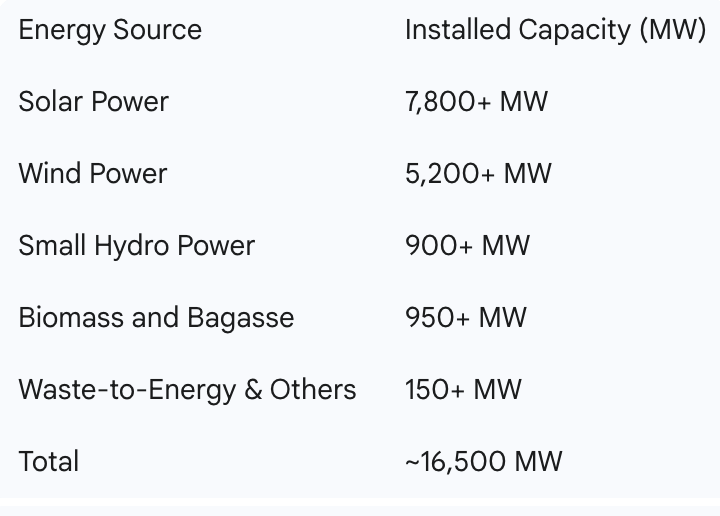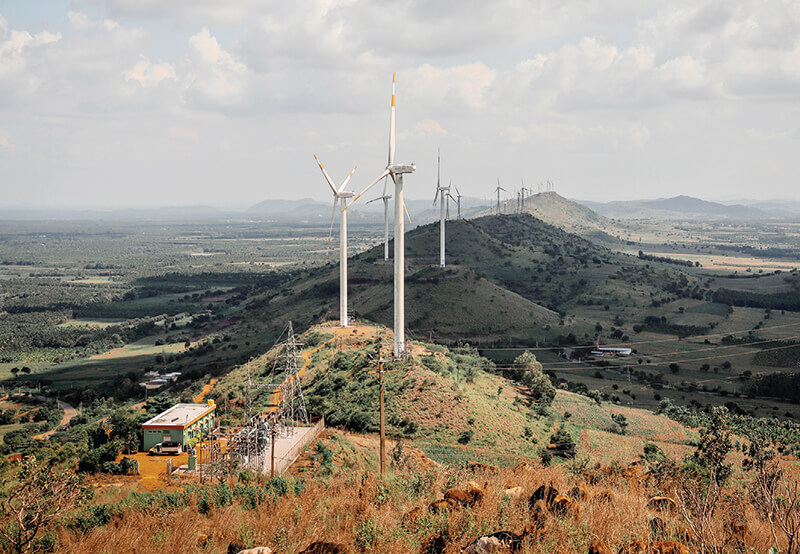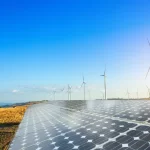Karnataka’s Renewable Push: Leading India’s Clean Energy Transition
This state, which is often claimed to be a home of flourishing IT centers and rich culture, is currently catching the attention of the press due to a quite alternative reason- its top positions in the renewable energy transformation in India. Climate change is further intensifying and energy security across the world is becoming a key issue in the agenda and Karnataka renewable energy is yet another instance of foresight, ambition, and action. Karnataka with its well-built infrastructure, aggressive policies, and significant institutional support is setting an example to other states in the country as a leader in clean energy.

At the heart of this transition lies a powerful blend of renewable energy sources in Karnataka, including solar, wind, hydro, and bioenergy. These non-fossil fuels cut the reliance of the state on fossil fuels in addition to helping in cutting down carbon emissions and minimizing climate risks. Backed by the progressive Karnataka renewable energy policy, the state has achieved significant milestones in renewable capacity addition and energy efficiency.
Through this complete guide, we will look at the experience of Karnataka in clean energy, its policies, accomplishments, and limitations and the way forward. We will address commonly asked questions, demystify some of the myths and we will outline the economic and environmental advantages enjoyed by renewable energy programs in the state.
1. Why Karnataka? Understanding the State’s Strategic Renewable Energy Push
Karnataka is not just another Indian state dabbling in renewable energy. It is the first Indian state to cross the 15,000 MW mark in renewable energy capacity, outpacing even larger, resource-rich states. According to official records, Karnataka’s renewable energy capacity stood at over 16,500 MW by the end of 2023, accounting for nearly 60% of its total installed power capacity. This makes Karnataka a true outlier in India’s traditionally thermal-focused power sector.
The state’s progress is not accidental. It stems from a clear political vision and administrative intent laid down by Karnataka Renewable Energy Development Limited (KREDL)—a government agency that has been at the forefront of driving awareness, policy implementation, and investor facilitation in the clean energy space.
What sets Karnataka apart?
- Favorable climate and geography: High solar insolation in the north and strong wind corridors in the south-west.
- Proactive government policies: Incentives, ease of doing business, and clear land allotment procedures.
- Strong grid infrastructure: Integration of renewable power into the transmission and distribution networks.
- Private sector participation: Karnataka attracts both domestic and international renewable energy companies due to its transparent policies and investor-friendly approach.
2. Overview of Karnataka Renewable Energy Policy
A major driver behind Karnataka’s clean energy leadership is its renewable energy policy, which has evolved steadily over the years. The Karnataka Renewable Energy Policy 2022-2027 builds on the success of earlier frameworks and outlines bold targets to scale clean energy adoption across solar, wind, hybrid, and decentralized systems.
Some highlights of the current policy include:
- Target to add 20,000 MW of renewable energy by 2027
- Emphasis on hybrid projects—wind-solar and solar-hydro combinations for 24/7 green energy supply
- Promotion of rooftop solar in urban and semi-urban areas
- Support for green hydrogen, bioenergy, and emerging technologies
- Focus on energy storage solutions to manage intermittency and grid reliability
- Incentives for MSMEs and startups in clean tech sectors
Through this policy, Karnataka aims not only to be an energy-surplus state but also to become a hub for green industrialization and innovation.
3. Karnataka Renewable Energy Capacity: A Snapshot
As of the latest figures available, Karnataka’s renewable energy capacity includes the following:

This dynamic portfolio of renewable energy sources in Karnataka allows the state to maintain a reliable, green, and diversified energy mix. It has also helped reduce Karnataka’s dependency on conventional thermal power, contributing significantly to its carbon footprint reduction.
4. Karnataka Renewable Energy Limited (KREDL): The Backbone of the Revolution
Established as a nodal agency, Karnataka Renewable Energy Development Limited (KREDL) is a pivotal institution in the state’s clean energy mission. KREDL is responsible for:
- Implementing state and central renewable energy schemes
- Approving and facilitating private-sector renewable projects
- Conducting feasibility studies and resource assessments
- Spreading public awareness on energy efficiency and conservation
- Monitoring off-grid and rural electrification projects
Over the years, KREDL has created a strong ecosystem for renewable energy investors, project developers, and researchers, cementing Karnataka’s reputation as a clean energy-friendly state.
5. Karnataka’s Renewable Energy Model: Simple Yet Scalable
The reason why it has been successful is that the model concept of Karnataka is quite easy to design and can be executed at a larger scale. With its focus on transparent policy, single-window clearance, transparency in data and easy land availability, it is appealing to developers of all scales of renewable energy.
Depolitictization of the energy sector through decentralization into cities such as Bengaluru, where solar panels on rooftops are encouraged and attempts that encourage solar water pumps among farmers in rural settings have ensured that clean energy penetrates every possible spectrum. Beyond the local level, there is a larger social and economic influence being developed via this grassroots approach, such as decreasing electricity bills and enhancing agricultural productivity.
6. Karnataka and India’s Energy Goals: A National Role Model
India has committed to achieving 500 GW of non-fossil fuel energy by 2030 under its Nationally Determined Contributions (NDCs) in the Paris Agreement. Karnataka, with its existing momentum and future potential, is expected to contribute significantly to this target.
By showing that sustainable energy is not just a concept but a working reality, Karnataka is creating a blueprint for other Indian states. Its success demonstrates that clean energy transitions are not only feasible but also economically rewarding and socially inclusive.
Conclusion: Karnataka’s Green Energy Legacy in the Making
As India accelerates toward a greener, more sustainable future, Karnataka’s renewable energy success stands out as a compelling case study. With its visionary policies, robust infrastructure, and inclusive approach, the state proves that economic growth and environmental responsibility can go hand in hand.
Karnataka is no longer just the Silicon Valley of India—it’s fast becoming the clean energy capital too. And with the ongoing support of institutions like Karnataka Renewable Energy Limited, and the implementation of dynamic policies, the state is well on its way to leading not just India, but potentially the global South, in renewable energy transformation.
Whether you’re a policymaker, investor, researcher, or simply a citizen concerned about climate change, Karnataka offers a powerful example of what’s possible when innovation, governance, and public interest come together.
Frequently Asked Questions (FAQs)
Karnataka’s renewable portfolio includes solar, wind, small hydro, biomass, bagasse cogeneration, and waste-to-energy projects.
It is the state’s current policy document that outlines strategies, incentives, and targets to expand clean energy capacity to 20,000 MW by 2027 across various sources.
KREDL is the nodal government agency responsible for promoting and implementing renewable energy and energy efficiency projects in Karnataka.
As of 2023, Karnataka has an installed renewable energy capacity of approximately 16,500 MW, with solar and wind being the leading contributors.
Yes, Karnataka has one of the highest installed solar capacities in India, with over 7,800 MW of grid-connected solar power, including large-scale parks and rooftop systems.












